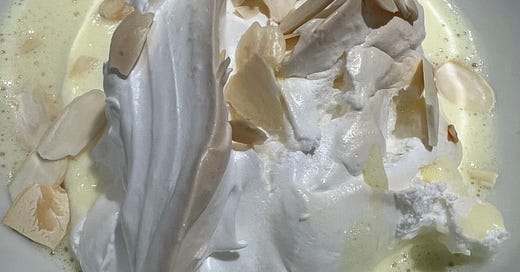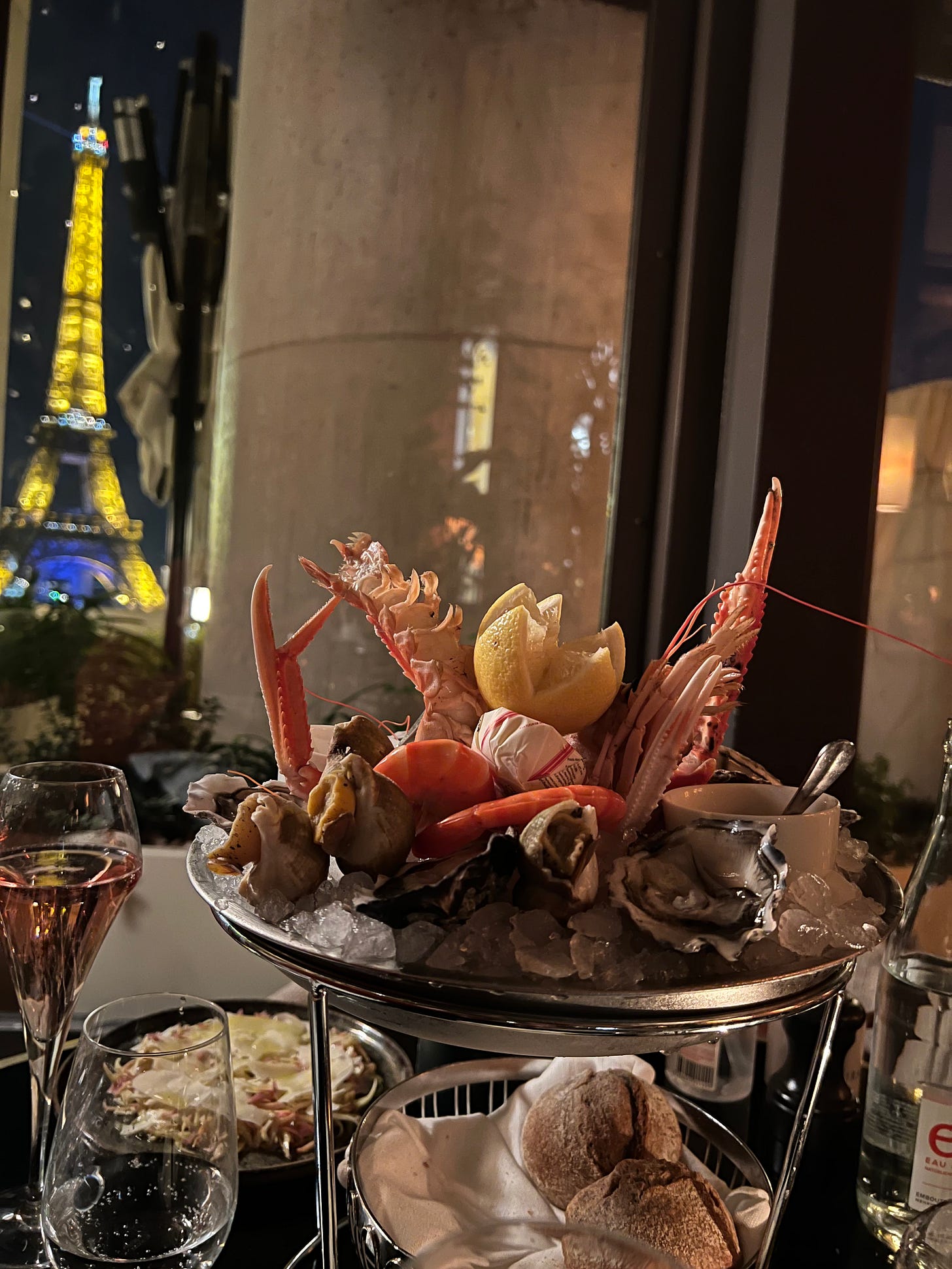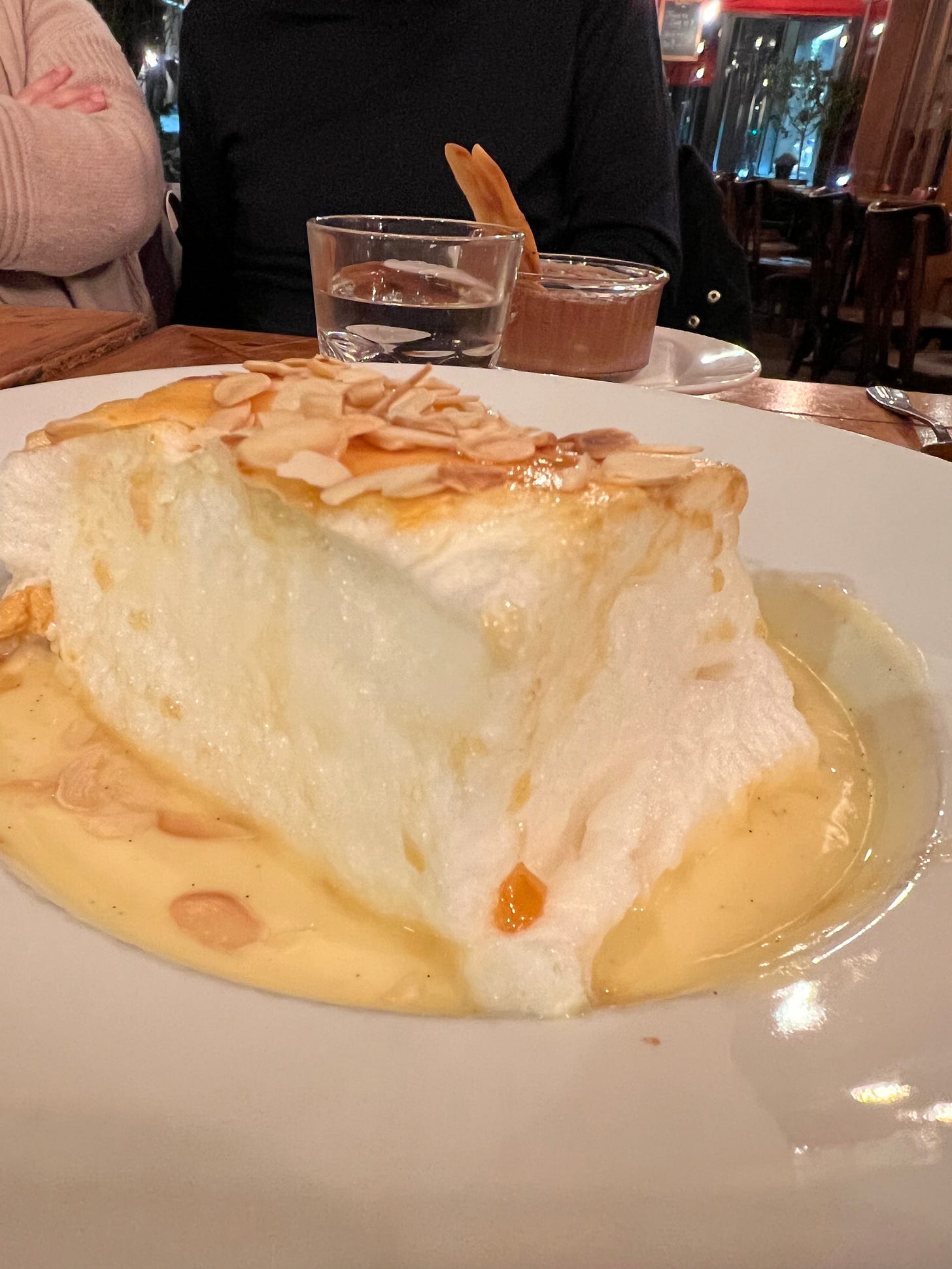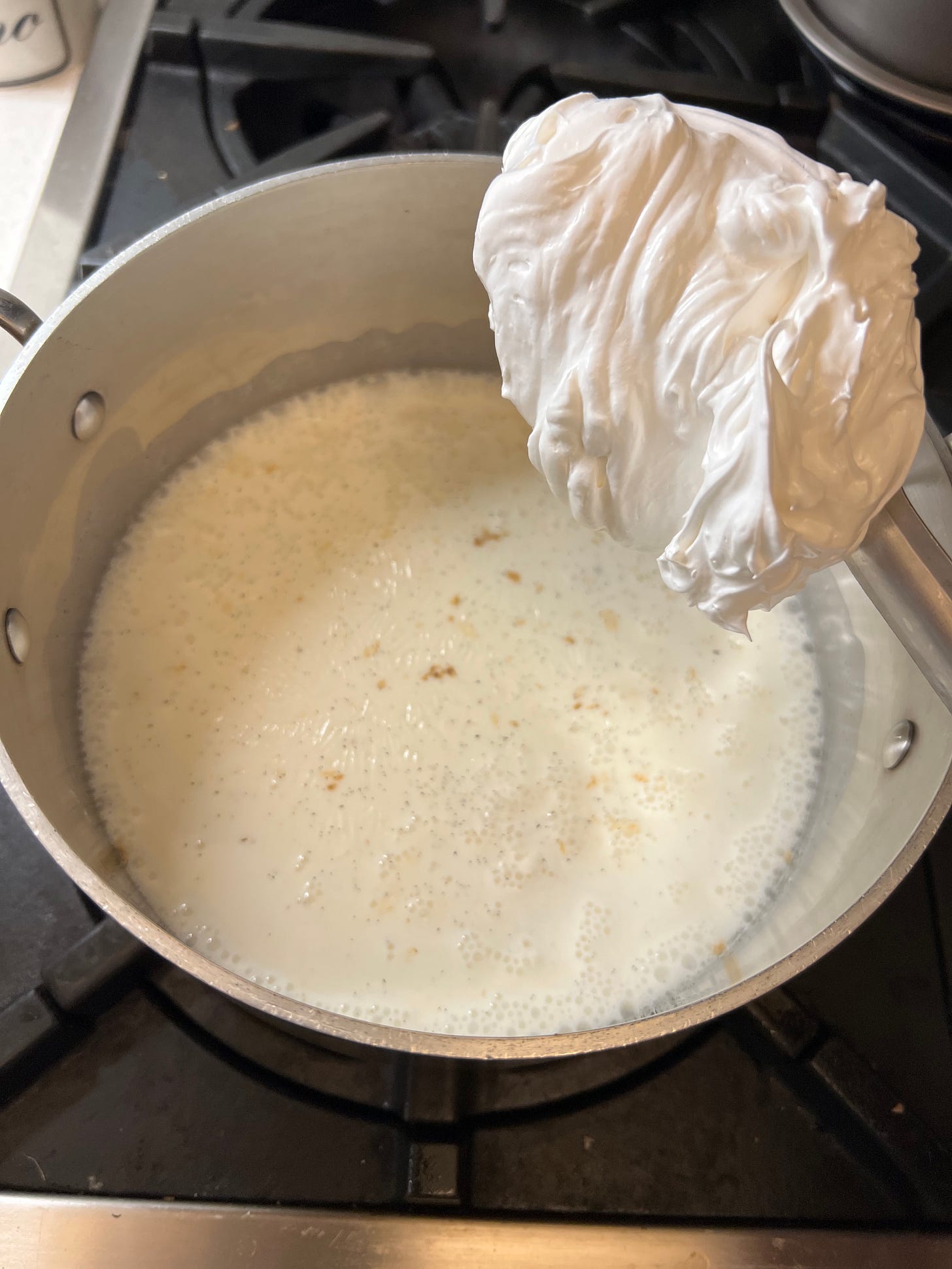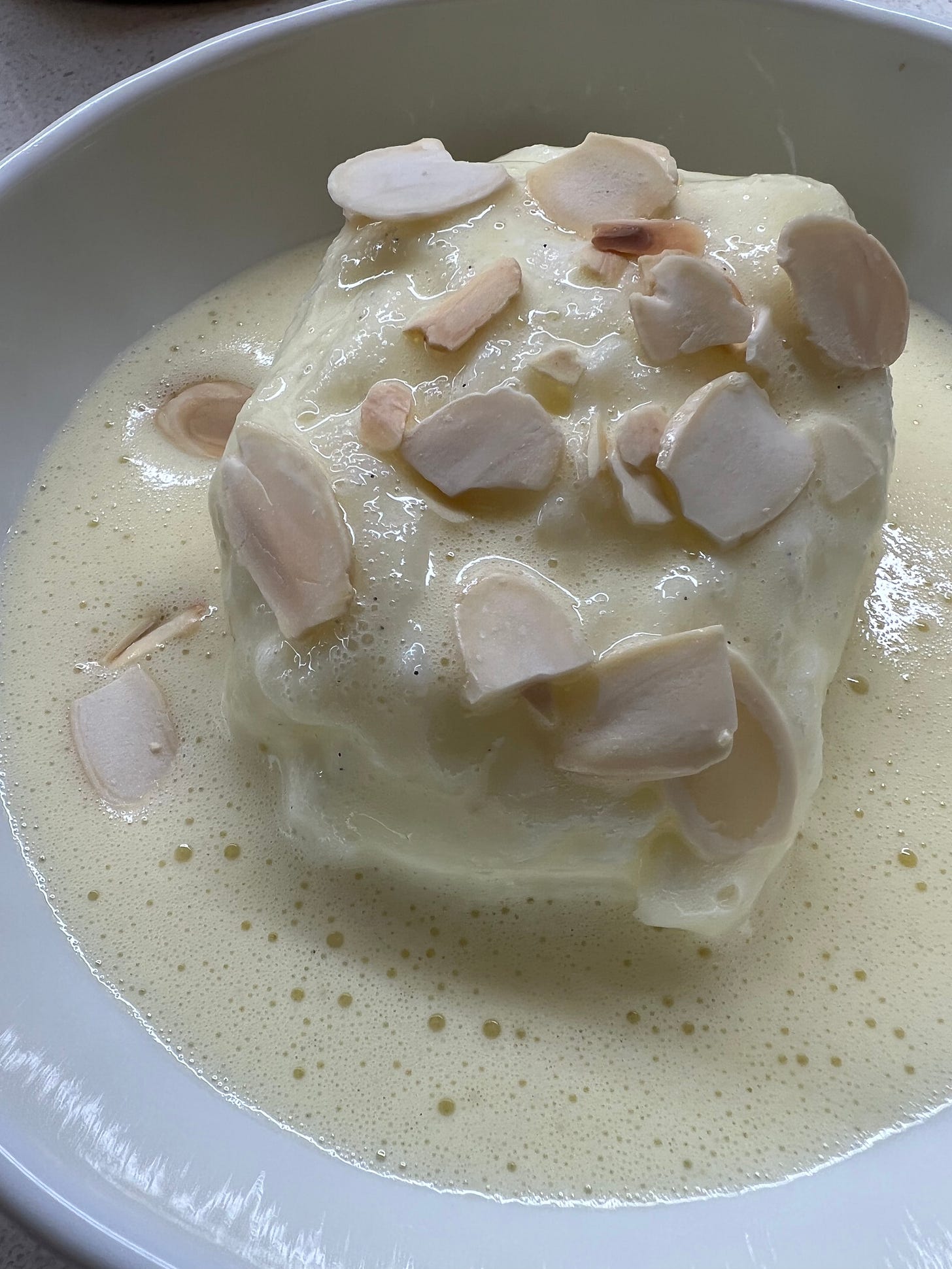No Man Is a Floating Island: Reflections on Europe During a Pandemic and a French Dessert
Dateline Europe, Comparing and Contrasting Pandemic Responses, Recipe for Île Flottante, whether Baked or Poached
We are back in New York and looking forward to staying home for a while as Omicron does its thing. I plan to get through this time, these holidays, this winter by cooking delicious things that I will share with you in this newsletter. I hope you can find some time for yourself in the kitchen, too. Thank you to all who have signed up. And double thank you to those who have paid to subscribe and thereby support this form of independent food writing. I know that I have not been great about giving paid subscribers special bonus content. In part, this is because I believe that if I’m to succeed at my personal project of getting more people into the kitchen to cook so they can eat well, I don’t believe anyone should have to pay more or less than someone else for that advice. And I haven’t found the right value proposition outside the main newsletter for those who do pony up. I’d be happy to hear what those of you who subscribe would like learn more about, and in fact, the ability to comment and make requests of me is one of the main benefits of a paid subscription. In the meantime, for paid subscribers I intend to prepare a guide to the great restaurants and other food shops we just visited in Paris, Milan, and Brussels, so you can start making your own delicious plans when things feel safe again to travel. Happy Holidays to all. —Mitchell
I started writing this newsletter on the plane on the way home from a ten-day vacation in Europe, spent mostly in Paris, but with quick detours to Milan and Brussels. We left just as Omicron was spreading out of control and countries in Europe, as in the rest of the world, were reacting by changing travel regulations, closing borders, and reinstating other restrictions. Of course, we’ve questioned whether we should have gone at all and felt more than a frisson of guilt about our decision. As with every decision these days, we took a calculated risk.
Putting the decision to go aside, we were struck by the different atmosphere in Europe as compared to New York City. Since the start of the pandemic, it’s been hard to overcome a pervasive feeling of doom in Manhattan. Although the coronavirus will ultimately be blamed, this sense comes from more than just the grief of lives lost and livelihoods upended by COVID-19. Rather it’s the sum of the pandemic combined with the political upheaval wrought by Trump and his band of crooks, the racial justice reckoning still revealing upsetting realities underlying so many aspects of our day-to-day lives, the stark and disparate effects of COVID-19 on communities of color, the mass layoffs and subsequent labor shortages that have made it difficult for any business to return to its A-game, the empty storefronts and empty shelves, the homeless people in the streets, the impact of inflation that also seems to be affecting communities disparately, if only because affluent people seem to have more money than ever and those with less have less still. I can’t help but feel in America, it is mostly the upper classes who are desperate to make it seem like everything is back to normal, while the lower classes, who make up a large proportion of the essential workers, keep screaming that nothing can or should go back to how it was. It’s no wonder the labor shortage has affected the lowest paying jobs disproportionately.
A Different Atmosphere in Europe
We didn’t see or sense these same tensions and woes in any of our European stops, and especially not in Paris. This contrast became the subject of many of our conversations with local friends, who noted first off that everywhere we went benefited from nationalized health care that covers all citizens, not just those with the most and the least money. And as all the statistics show, during a deadly pandemic you can’t underestimate the difference in outcomes of those who have health insurance and those who do not. Also important is that for the most part in Europe government financial support came through businesses so employees could be retained even while they weren’t working. Staying employed, feeling supported by those to whom you have given so much, is no doubt a tremendous boost, not just economically, but also for morale. We sensed a different level of engagement in the motions of daily life—the markets, the bakeries, the restaurants, and other cultural happenings—one that seemed genuine and authentic, rather than performative and false.
Granted we were on vacation. The same way the food often tastes better when you are away, I’m sure our observations were tinged with the romance of being abroad. But the people we were hanging out with were not visitors. And they seemed fascinated by our stories of staff mutinies in restaurants and shuttered storefronts lining the streets of our neighborhood. I know that nowhere is paradise. There are antivaxxers in Europe, as there are everywhere. I know there is no European country that doesn’t wrestle with structural racism in all its insidious forms. Right-wing factions are gaining power across the continent, too. Restaurant work can suck in restaurants everywhere.
But when a limited work week and paid sick leave and healthcare are available to everyone, the tradeoffs are different. Sure, people are frustrated, bored, fed up with having to deal with a virus that doesn’t seem to be going away any time soon. But they don’t seem desperate to get off this bus the way so many of my friends and colleagues in the U.S. do. Even the efficiency of the Passe Sanitaire, the app that shows vaccination status, results of recent tests, and provides a QR code that is scanned before you can enter any business or public place, seems a more effective and egalitarian way to handle the movement of people during the time of a global pandemic. We were able to use it not just in France, but also in Italy and Belgium. An important message was much clearer: we are all in this together.
A Culture of Restaurants versus a Culture of Consumption
I was also struck by how the pandemic exposed the difference the culture of food and restaurants plays in Europe, especially in Paris and Milan. The few times I’ve dined out in New York in the last few months I’ve been aware how much of the performance of restaurant dining is about spending money and consumption, about being served. I’ve heard people say they can’t wait to drop a ton of money in restaurants again, without much concern for what they are spending it on, as long as it’s “the best.” Others have said they just want to dine out so they can be waited on. I have only my limited experience to go on, but my feeling is this is different in Europe. Consumption isn’t the goal but the means. We should want to eat in restaurants again because we find something nourishing and pleasurable in the food, in the environment, in the sociality of breaking bread, something that connects us with our culture, our humanity, something that goes beyond just the feeling that we are rich enough to do so. Without evidence of that kind of cultural contribution, beyond “feeding the rich,” difficult restaurant jobs are made even harder.
Worried, anxious, and working to survive the last two years, most people in the hospitality industry in the U.S. are burnt out. They didn’t have “time off” during the pandemic; they were struggling to get by. Coupled with the current labor shortage, due in large part to those who decided the struggle wasn’t worth it, the result is utter exhaustion. I see it in the eyes of people in restaurants everywhere I’ve been in the U.S. During high season in Portland, Maine, this summer I was particularly struck with how tired everyone seemed. Demand is high, but no one seems to be able to function in top form. Menus are shortened, dishes are less complex, service has suffered, all while prices are rising. More often than not the dining experience is disappointing, however much you understand the reasons why. And that leaves no one satisfied, let alone happy.
This was not our experience in Europe, where restaurants were closed for as much as 18 months , but people didn’t fear for their existence. Restaurants seemed lively and fresh. Even the older couple who run my favorite restaurant in Milan, Arturo and Maria Maggi of Latteria San Marco—she in her 70s, he in his 80s—seemed younger, fresher, rejuvenated. Their son Marco said the pandemic was the first time in almost 50 years his parents weren’t working for an extended period of time. They walked the streets of Milan holding hands like they were dating again.
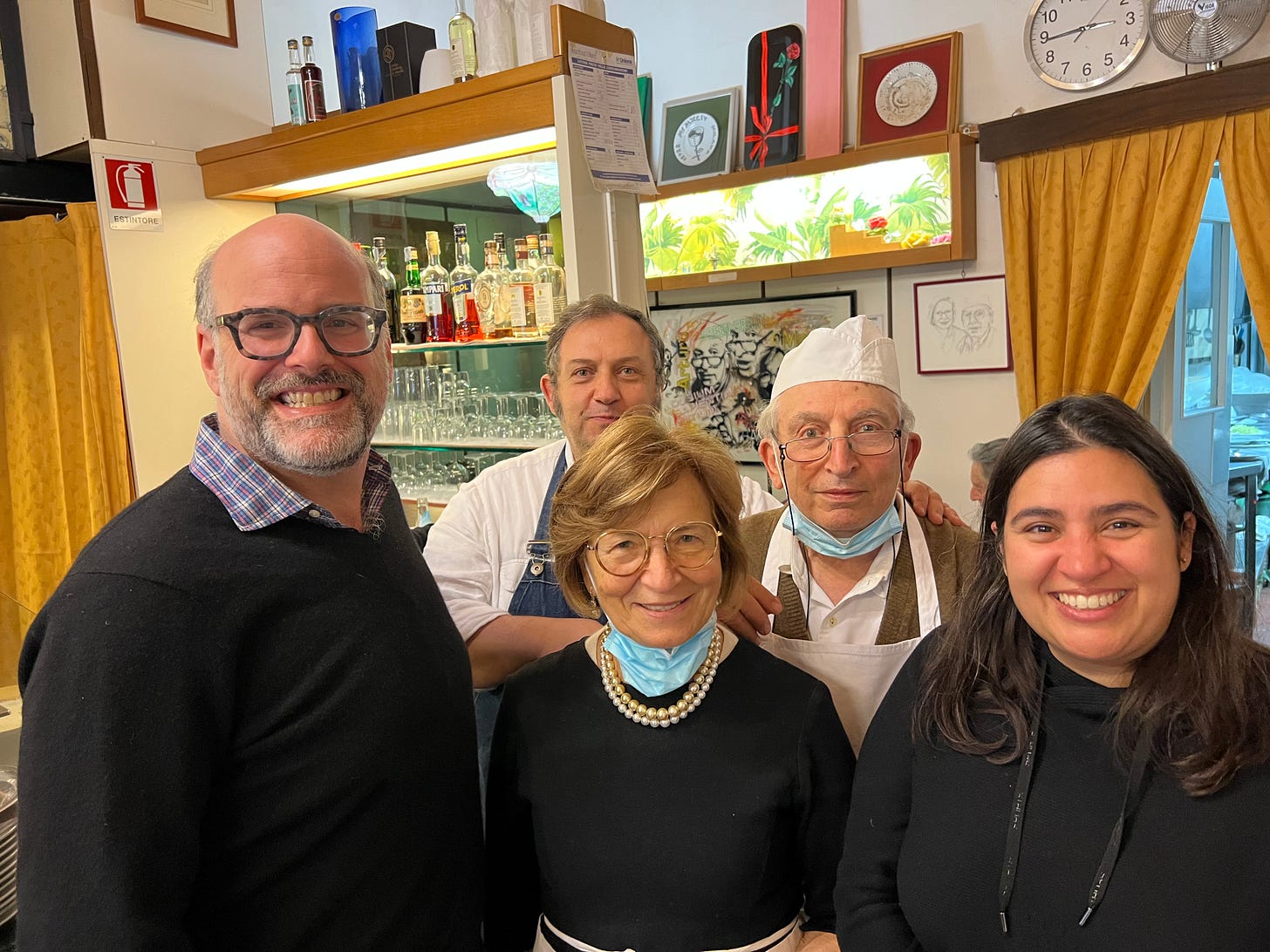
While I’m in this compare and contrast mode, I also can’t help but reflect on how much more integrated a care for the environment seems to be in the food sector of Europe, how provisions to help combat climate change are obvious everywhere you go. I was impressed that an organic shop in Brussels had glass Weck containers for its bulk items until I saw the same containers used in a gourmet cheese shop across the way and at another store down the block. The vanilla yogurt I took from an airport lounge came in a paper cup, from a commercial brand, no less. Any take out food we ordered came in compostable containers with wooden utensils. And this was not just from businesses “with a conscience”'; Delta Airlines gave us wooden forks and spoons.
A French Dessert for the Holidays…or Any Day
While we were in Paris, we ate delicious food, of course—from restaurants, markets, bakeries, gourmet shops, and traiteurs—that both nourished and inspired. But it was a dessert in a small, nondescript neighborhood restaurant at the end of our last meal out (dining plans having been clipped due to Omicron) that I thought might be most appropriate to convey to you for an uncertain holiday season that still requires some festivity, but without too much effort, affording a high culinary ROI, if you will.
The restaurant was Chez Margot, a typical bistro just downstairs from the apartment of the friends with whom we were staying. Margot has an all-day menu that features beef from the ancient Salers breed, along with typical French fare. It is all comme il faut, but the classic French dessert Île Flottante (or “Floating Island”) was, for me, the most memorable part of our meal. In part, that’s because I love the combination of meringue, crème anglaise, and toasted almonds, whatever form it takes. But also because Île Flottante strikes me as being, well, just so French. I’ve made floating islands for dessert a couple of times during the pandemic to feel like we were traveling. It is a dessert impressive enough to end a festive holiday meal, but easy enough to make for a weeknight dinner.
There are two options for cooking the meringues islands that are destined to float. It’s more traditional to poach them in milk, which produces an ethereal, somewhat creamy result. If you know me, you’ll know I choose not to waste that milk, and instead poach the meringues, allow them to cool, and then use the poaching milk to make the custard sauce. This requires a little extra time, since you can’t make the sauce ahead and you need to chlll the sauce before you can serve it. You can also bake the meringues, which gives the nice texture contrast of a crisp outer shell, and which allows you to make and chill the sauce in advance. If you choose to bake, you also have the option of making a larger island you can divide up like a real estate baron into individual portions, as they did at Chez Margot. Whichever route you take, the results are delicious, so I’ve given you instructions for both.
RECIPE: Îles Flottantes
(Serves 6)
2 cups whole milk
½ vanilla bean split and scraped, or 1 teaspoon vanilla paste or extract
4 large eggs
¼ teaspoon cream of tartar
Salt
1/2 + 1/3 cup sugar
Pinch salt
1 teaspoon cornstarch (optional, but helpful to alleviate some egg-curdling anxiety)
2 tablespoons sliced almonds, toasted
Place the milk and the vanilla bean pod and scrapings or paste into a wide saucepan and set aside. Separate the eggs, placing the egg whites into the clean bowl of an electric mixer and the yolks into a small mixing bowl. To the whites add the cream of tartare and a pinch of salt. Beat with the whisk attachment on medium high until the whites form soft peaks. At that point, increase the speed and begin to add the ½ cup of sugar gradually while continuing to beat until the whites from stiff, glossy peaks and the sugar has dissolved. To check, rub a smidge of meringue between your fingers. It shouldn’t feel grainy. Line a sheet pan with parchment.
If poaching the meringues, set the pot with the milk and vanilla over medium-low heat and bring to a simmer. Keep an eye on it so it doesn’t boil over. Remove the vanilla bean pod. Use a large spoon to scoop billowy clouds of meringue into the milk. Don’t crowd the pan. I can’t fit more than two or three at a time in mine. Cook for 2 ½ minutes, and then using a clean slotted spoon, gently turn the meringues over and cook another 2 ½ minutes. With the slotted spoon, remove the meringues to the parchment lined pan. Repeat with the remaining meringue. You should get six îles in total.
If baking the meringues, preheat the oven to 325°F. No need to simmer the milk with the vanilla until just before you are ready to make the sauce. Spray the parchment on the sheet pan lightly with non-stick spray. Spoon six pillows of meringue onto the prepared pans. They should all be about the same size, though I like the shapes to vary. No need to worry about providing too much space, as the meringues will not expand in the oven but they should not touch. Bake for about 15 minutes, until the swirls begin to brown and the meringues have set. Remove from the oven to cool. Bring the milk with the vanilla to a simmer.
To prepare the crème anglaise, fill a large bowl halfway with ice, then fill it two thirds of the way to the top with cold water. Have a medium bowl, fine-mesh strainer, and small clean saucepan at the ready. To the egg yolks, add the remaining 1/3 cup of sugar and the cornstarch, if using, and whisk until thick and light. While continuously whisking, strain some of the hot milk into the yolk and sugar mixture to temper it. Then strain in the rest. (The straining is important to remove any film whether or not you poached the meringues in the milk.) Pour this mixture back into a clean saucepan and set over low heat, stirring continuously with a rubber spatula or wooden spoon until the mixture thickens enough to coat the back of the spoon, just 4 or 5 minutes. Immediately strain the custard into clean medium bowl and set over the ice, stirring to cool.
To serve, spoon a pool of crème anglaise into six bowls. If baked, carefully remove the meringues from the parchment. The spray helps prevent sticking, but sometimes I find they still adhere. Place the meringue islands in the center of the sauce and sprinkle with toasted almonds. Serve any remaining custard on the side.
Bon appétit.
